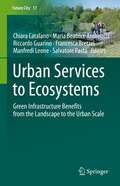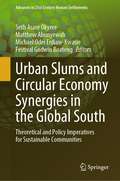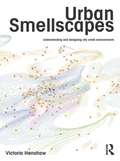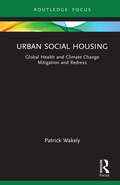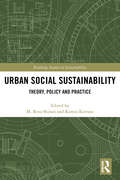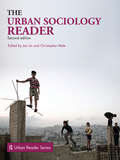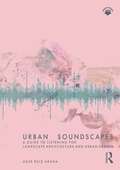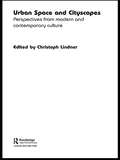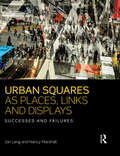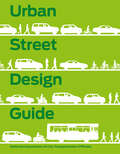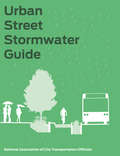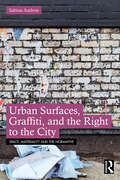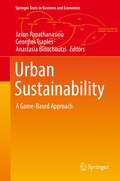- Table View
- List View
The Urban Section: An analytical tool for cities and streets
by Robert ManthoThe design of streets, and the connections between streets of different character, is the most important task for architects and urbanists working in an urban context. Considered at two distinct spatial scales – that of the individual street – the Street Section – and the complex of city streets – the City Transect – Urban Section identifies a range of generic street types and their success or otherwise in responding to climatic, cultural, traditional, morphological, social and economic well being. Using comparative studies a profile of best practice in street and city design is identified, showing methodologies in both the analysis of, and design for, successful streets and public places – place-making. In uniquely dealing with both the historic and contemporary description and analysis of urban ‘streets’ around the world, the work is of both academic and professional interest to architects, urban planners and designers, highway engineers, landscape and urban design advisers in both the public and private sectors; students, amenity and civic societies, city authorities and government agencies.
The Urban Section: An analytical tool for cities and streets
by Robert ManthoThe design of streets, and the connections between streets of different character, is the most important task for architects and urbanists working in an urban context. Considered at two distinct spatial scales – that of the individual street – the Street Section – and the complex of city streets – the City Transect – Urban Section identifies a range of generic street types and their success or otherwise in responding to climatic, cultural, traditional, morphological, social and economic well being. Using comparative studies a profile of best practice in street and city design is identified, showing methodologies in both the analysis of, and design for, successful streets and public places – place-making. In uniquely dealing with both the historic and contemporary description and analysis of urban ‘streets’ around the world, the work is of both academic and professional interest to architects, urban planners and designers, highway engineers, landscape and urban design advisers in both the public and private sectors; students, amenity and civic societies, city authorities and government agencies.
Urban Services to Ecosystems: Green Infrastructure Benefits from the Landscape to the Urban Scale (Future City #17)
by Chiara Catalano Maria Beatrice Andreucci Riccardo Guarino Francesca Bretzel Manfredi Leone Salvatore PastaThe aim of this book is to bring together multidisciplinary research in the field of green infrastructure design, construction and ecology. The main core of the volume is constituted by contributions dealing with green infrastructure, vegetation science, nature-based solutions and sustainable urban development. The green infrastructure and its ecosystem services, indeed, are gaining space in both political agendas and academic research. However, the attention is focused on the services that nature is giving for free to and for human health and survival. What if we start to see things from another perspective? Our actions shall converge for instance to turn man-made environment like cities from heterotrophic to autotrophic ecosystems. From landscape ecology to urban and building design, like bricks of a wall, from the small scale to the bigger landscape scale via ecological networks and corridors, we should start answering these questions: what are the services that are we offering to Nature? What are we improving? How to implement our actions? This book contains three Open Access chapters, which are licensed under the terms of the Creative Commons Attribution 4.0 International License (CC BY 4.0).
Urban Slums and Circular Economy Synergies in the Global South: Theoretical and Policy Imperatives for Sustainable Communities (Advances in 21st Century Human Settlements)
by Seth Asare Okyere Matthew Abunyewah Michael Odei Erdiaw-Kwasie Festival Godwin BoatengThis book takes a theoretical and empirical distance from urban slums/low-income settlements as a threat to environmental sustainability and recast them as places where environmentally rehabilitative and circular practices occur—drawing on the theoretical lens of the circular economy (CE). CE is defined as regenerative system that minimizes waste, emission, and energy leakage by slowing, closing, and narrowing material and energy loops. In principle, CE departs from the traditional linear model of take-make-use-dispose. As conceived in urban contexts, circular cities offer possibilities to regenerate natural systems, design out waste, and keep products in use. While the CE key principles of reduce, repair, and reuse are essential to the sustainable and inclusive interventions in urban slums, there is lack of case studies exploring the role of place and agency, especially the slum living-CE nexus in global south contexts. In inequitable urban transitions, a nuanced understanding of thesynergies between urban slums and the circular economy is not only theoretically relevant for reconceptualizing the slum in urban sustainability discourses but also exert policy and practice ramifications to decidedly figure out how the urban slum phenomenon can foster the sustainable and inclusive development of marginal areas through contextual and people-centered initiatives.
Urban Smellscapes: Understanding and Designing City Smell Environments
by Victoria HenshawWe see the city, we hear the city, but above all: we smell the city. Scent has unique qualities: ubiquity, persistence, and an unparalleled connection to memory, yet it has gone overlooked in discussions of sensory design. What scents shape the city? How does scent contribute to placemaking? How do we design smell environments in the city? Urban Smellscapes makes a notable contribution towards the growing body of literature on the senses and design by providing some answers to these questions and contributing towards the wider research agenda regarding how people sensually experience urban environments. It is the first of its kind in examining the role of smell specifically in contemporary experiences and perceptions of English towns and cities, highlighting the perception of urban smellscapes as inter-related with place perception, and describing odour’s contribution towards overall sense of place. With case studies from factories, breweries, urban parks, and experimental smell environments in Manchester and Grasse, Urban Smellscapes identifies processes by which urban smell environments are managed and controlled, and gives designers and city managers tools to actively use smell in their work.
Urban Smellscapes: Understanding and Designing City Smell Environments
by Victoria HenshawWe see the city, we hear the city, but above all: we smell the city. Scent has unique qualities: ubiquity, persistence, and an unparalleled connection to memory, yet it has gone overlooked in discussions of sensory design. What scents shape the city? How does scent contribute to placemaking? How do we design smell environments in the city? Urban Smellscapes makes a notable contribution towards the growing body of literature on the senses and design by providing some answers to these questions and contributing towards the wider research agenda regarding how people sensually experience urban environments. It is the first of its kind in examining the role of smell specifically in contemporary experiences and perceptions of English towns and cities, highlighting the perception of urban smellscapes as inter-related with place perception, and describing odour’s contribution towards overall sense of place. With case studies from factories, breweries, urban parks, and experimental smell environments in Manchester and Grasse, Urban Smellscapes identifies processes by which urban smell environments are managed and controlled, and gives designers and city managers tools to actively use smell in their work.
Urban Social Housing: Global Health and Climate Change Mitigation and Redress
by Patrick WakelyThis book proposes operational approaches to public sector support to community-led development of urban low-income group social housing in the prevailing and medium-term. Within the context of mitigating and redressing the existential threats of climate change and global pathogenic transmission, building on current concerns of global heating and the lessons learnt from the 2020-22 COVID-19 pandemic, the book closely examines recent examples from a wide international range of countries and cities from the Sri Lanka experience to Arab States of the Middle East and the Andes. Topics include maintenance and management of public sector housing, poverty alleviation objectives, climate change mitigation, housing density, local land management and planning, land rights, affordable housing markets, and international governance and administration, ultimately pointing to the universal need for institutional, organisational and human skills development and the compilation and dissemination of operationally successful examples of participatory partnerships for affordable social housing. The book will be of interest to researchers, instructors, practitioners, and students of urban development, housing, environmental design, land-use planning, public administration and environmental health engineering.
Urban Social Housing: Global Health and Climate Change Mitigation and Redress
by Patrick WakelyThis book proposes operational approaches to public sector support to community-led development of urban low-income group social housing in the prevailing and medium-term. Within the context of mitigating and redressing the existential threats of climate change and global pathogenic transmission, building on current concerns of global heating and the lessons learnt from the 2020-22 COVID-19 pandemic, the book closely examines recent examples from a wide international range of countries and cities from the Sri Lanka experience to Arab States of the Middle East and the Andes. Topics include maintenance and management of public sector housing, poverty alleviation objectives, climate change mitigation, housing density, local land management and planning, land rights, affordable housing markets, and international governance and administration, ultimately pointing to the universal need for institutional, organisational and human skills development and the compilation and dissemination of operationally successful examples of participatory partnerships for affordable social housing. The book will be of interest to researchers, instructors, practitioners, and students of urban development, housing, environmental design, land-use planning, public administration and environmental health engineering.
Urban Social Sustainability: Theory, Policy and Practice (Routledge Studies in Sustainability)
by Ramin Keivani M. Reza ShiraziThis ground breaking volume raises radical critiques and proposes innovative solutions for social sustainability in the built environment. Urban Social Sustainability provides an in-depth insight into the discourse and argues that every urban intervention has a social sustainability dimension that needs to be taken into consideration, and incorporated into a comprehensive and cohesive ‘urban agenda’ that is built on three principles of recognition, integration, and monitoring. This should be achieved through a dialogical and reflexive process of decision-making. To achieve sustainable communities, social sustainability should form the basis of a constructive dialogue and be interlinked with other areas of sustainable development. This book underlines the urgency of approaching social sustainability as an urban agenda and goes on to make suggestions about its formulation. Urban Social Sustainability consists of original contributions from academics and experts within the field and explores the significance of social sustainability from different perspectives. Areas covered include urban policy, transportation and mobility, urban space and architectural form, housing, urban heritage, neighbourhood development, and urban governance. Drawing on case studies from a number of countries and world regions the book presents a multifaceted and interdisciplinary understanding from social sustainability in urban settings, and provides practitioners and policy makers with innovative recommendations to achieve more socially sustainable urban environment.
Urban Social Sustainability: Theory, Policy and Practice (Routledge Studies in Sustainability)
by M. Reza Shirazi Ramin KeivaniThis ground breaking volume raises radical critiques and proposes innovative solutions for social sustainability in the built environment. Urban Social Sustainability provides an in-depth insight into the discourse and argues that every urban intervention has a social sustainability dimension that needs to be taken into consideration, and incorporated into a comprehensive and cohesive ‘urban agenda’ that is built on three principles of recognition, integration, and monitoring. This should be achieved through a dialogical and reflexive process of decision-making. To achieve sustainable communities, social sustainability should form the basis of a constructive dialogue and be interlinked with other areas of sustainable development. This book underlines the urgency of approaching social sustainability as an urban agenda and goes on to make suggestions about its formulation. Urban Social Sustainability consists of original contributions from academics and experts within the field and explores the significance of social sustainability from different perspectives. Areas covered include urban policy, transportation and mobility, urban space and architectural form, housing, urban heritage, neighbourhood development, and urban governance. Drawing on case studies from a number of countries and world regions the book presents a multifaceted and interdisciplinary understanding from social sustainability in urban settings, and provides practitioners and policy makers with innovative recommendations to achieve more socially sustainable urban environment.
The Urban Sociology Reader (Routledge Urban Reader Series)
by Jan Lin Christopher MeleThe urban world is an exciting terrain for investigating the central institutions, structures and problems of the social world and how they have transformed through the last 200 years. This Reader comprises sections on urban social theory, racial and social difference in the city, culture in everyday life, culture and the urban economy, globalization and transnational social relations and the regulation of urban space. Drawing together seminal selections covering the nineteenth to the twenty-first centuries, this Reader includes forty-three significant writings from eminent names such as Simmel, Wirth, Park, Burgess, DuBois, Zukin, Sassen, and Harvey. The 2nd edition illuminates more recent urban issues such as sprawl, sustainability, immigration and urban protest. Selections are predominantly sociological, but some readings cross disciplinary boundaries. Providing an essential resource for students of urban studies, this book brings together important but, till now, widely dispersed writings. Editorial commentaries precede each entry; introducing the text, demonstrating its significance, and outlining the issues surrounding its topic, whilst the associated bibliography enables deeper investigations.
The Urban Sociology Reader (Routledge Urban Reader Series)
by Jan Lin Christopher MeleThe urban world is an exciting terrain for investigating the central institutions, structures and problems of the social world and how they have transformed through the last 200 years. This Reader comprises sections on urban social theory, racial and social difference in the city, culture in everyday life, culture and the urban economy, globalization and transnational social relations and the regulation of urban space. Drawing together seminal selections covering the nineteenth to the twenty-first centuries, this Reader includes forty-three significant writings from eminent names such as Simmel, Wirth, Park, Burgess, DuBois, Zukin, Sassen, and Harvey. The 2nd edition illuminates more recent urban issues such as sprawl, sustainability, immigration and urban protest. Selections are predominantly sociological, but some readings cross disciplinary boundaries. Providing an essential resource for students of urban studies, this book brings together important but, till now, widely dispersed writings. Editorial commentaries precede each entry; introducing the text, demonstrating its significance, and outlining the issues surrounding its topic, whilst the associated bibliography enables deeper investigations.
Urban Soundscapes: A Guide to Listening for Landscape Architecture and Urban Design
by Usue Ruiz AranaSound and listening are intrinsically linked to how we experience and engage with places and communities. This guide puts forward a new conceptual framework of embodied affectivity that emphasises listening in urban research and design and advances new ways of knowing and making. The guide invites landscape architects and urban designers to become soundscape architects and offers practical advice on sound and listening applicable to each stage of a design project: from reading the environment to intervening on it.Urban Soundscapes foregrounds listening as an affective mediator between subjects and multispecies environments, and a vehicle to think and conceptualise environmental research and design beyond prevailing visual and human-centred modes. The guide expands landscape architects’ and urban designers’ tools and skills to assess existing soundscapes, predict how those soundscapes will be altered through their designs, consider sound as a creative and active part of the design process and envisage how users might perceive and be affected by those soundscapes as they evolve in time. The volume sits in the interface of research and practice and interweaves theoretical, methodological and creative contributions from acoustic ecology, ecoacoustics, bioacoustics and sound art. Each of the design stages is illustrated through project examples that demonstrate the many advantages of incorporating attentive listening and sound into Landscape Architecture and Urban Design Practice. This book shows how incorporating listening and sounding as part of the design process promotes slow and subtle ways of practice, adds social and ecological value through the reduction of noise pollution and by monitoring the health of habitats, and enables the design of soundscapes that complement the character and design intent of a scheme and elicit joy and wonder.The book will be of interest to practitioners and academics in landscape architecture, and other design and spatial fields such as urban design, architecture, geography and engineering, who play a primary role in the composition of the soundscape.
Urban Soundscapes: A Guide to Listening for Landscape Architecture and Urban Design
by Usue Ruiz AranaSound and listening are intrinsically linked to how we experience and engage with places and communities. This guide puts forward a new conceptual framework of embodied affectivity that emphasises listening in urban research and design and advances new ways of knowing and making. The guide invites landscape architects and urban designers to become soundscape architects and offers practical advice on sound and listening applicable to each stage of a design project: from reading the environment to intervening on it.Urban Soundscapes foregrounds listening as an affective mediator between subjects and multispecies environments, and a vehicle to think and conceptualise environmental research and design beyond prevailing visual and human-centred modes. The guide expands landscape architects’ and urban designers’ tools and skills to assess existing soundscapes, predict how those soundscapes will be altered through their designs, consider sound as a creative and active part of the design process and envisage how users might perceive and be affected by those soundscapes as they evolve in time. The volume sits in the interface of research and practice and interweaves theoretical, methodological and creative contributions from acoustic ecology, ecoacoustics, bioacoustics and sound art. Each of the design stages is illustrated through project examples that demonstrate the many advantages of incorporating attentive listening and sound into Landscape Architecture and Urban Design Practice. This book shows how incorporating listening and sounding as part of the design process promotes slow and subtle ways of practice, adds social and ecological value through the reduction of noise pollution and by monitoring the health of habitats, and enables the design of soundscapes that complement the character and design intent of a scheme and elicit joy and wonder.The book will be of interest to practitioners and academics in landscape architecture, and other design and spatial fields such as urban design, architecture, geography and engineering, who play a primary role in the composition of the soundscape.
Urban Space and Cityscapes: Perspectives from Modern and Contemporary Culture
by Christoph LindnerFrom the verticals of New York, Hong Kong and Singapore to the sprawls of London, Paris and Jakarta, this interdisciplinary volume of new writing examines constructions, representations, imaginations and theorizations of 'cityscapes' in modern and contemporary culture. With specially-commissioned essays from the fields of cultural theory, architecture, film, literature, visual art and urban geography, it offers fresh insight into the increasingly complex relationship between urban space, cultural production and everyday life. This volume draws on critical urban studies and moves beyond familiar cultural representations of the city by considering urban planning and architecture. Organized under three inter-related themes - image, text and form - essay topics range from the examination of cyberpunk skylines, pagan urbanism and the cinema of urban disaster, to the analysis of iconic city landmarks such as the twin towers, the London Eye and the Judisches Museum Berlin. Covering a diverse range of cities, including Berlin, Chicago, Jakarta, Johannesburg, Hong Kong, London, Los Angeles, Paris, and Venice, this fantastic resource for students, scholars and researchers alike, works expertly at the intersections of visual, material, and literary culture.
Urban Space and Cityscapes: Perspectives from Modern and Contemporary Culture
by Christoph LindnerFrom the verticals of New York, Hong Kong and Singapore to the sprawls of London, Paris and Jakarta, this interdisciplinary volume of new writing examines constructions, representations, imaginations and theorizations of 'cityscapes' in modern and contemporary culture. With specially-commissioned essays from the fields of cultural theory, architecture, film, literature, visual art and urban geography, it offers fresh insight into the increasingly complex relationship between urban space, cultural production and everyday life. This volume draws on critical urban studies and moves beyond familiar cultural representations of the city by considering urban planning and architecture. Organized under three inter-related themes - image, text and form - essay topics range from the examination of cyberpunk skylines, pagan urbanism and the cinema of urban disaster, to the analysis of iconic city landmarks such as the twin towers, the London Eye and the Judisches Museum Berlin. Covering a diverse range of cities, including Berlin, Chicago, Jakarta, Johannesburg, Hong Kong, London, Los Angeles, Paris, and Venice, this fantastic resource for students, scholars and researchers alike, works expertly at the intersections of visual, material, and literary culture.
Urban Spatial Evolution Simulation: Theory, Method, and Practice (Urban Sustainability)
by Fangqu NiuThis book provides a comprehensive introduction to the LUTI model from many aspects such as principles, methods and practice. Since the geometric revolution in the 1960s, model simulation methods have been used in some developed countries to study the development process of urban space and to support urban spatial decision making. One of the most common models is the Land Use Transport Interaction (LUTI) model. At present, relevant research is also gradually emerging in developing countries. This book has the following features: 1. The theory and methods of urban spatial development simulation have been systematically summarised, and practical application research has been carried out. 2. The LUTI model has been systematically explored from theory and implementation method to application practice. 3. The "activity-based" modelling techniques used are at the forefront of LUTI model development.
Urban Sprawl in Europe: Landscape, Land-Use Change and Policy
by Chris Couch Gerhard Petschel-Held Lila LeontidouUrban sprawl is one of the most important types of land-use changes currently affecting Europe. It increasingly creates major impacts on the environment (via surface sealing, emissions by transport and ecosystem fragmentation); on the social structure of an area (by segregation, lifestyle changes and neglecting urban centres); and on the economy (via distributed production, land prices, and issues of scale). Urban Sprawl in Europe: landscapes, land-use change & policy explains the nature and dynamics of urban sprawl. The book is written in three parts. Part I considers contemporary definitions, theories and trends in European urban sprawl. In part II authors draw upon experiences from across Europe to consider urban sprawl from a number of perspectives: Infrastructure-related sprawl, such as can be seen around Athens; Sprawl in the post-socialist city, as typified by Warsaw, Leipzig and Ljubljana; Decline and sprawl, where a comparative analysis of Liverpool and Leipzig shows that sprawl is not confined to expanding cities; Sprawl based on the development of second homes as found in Sweden, Austria and elsewhere. In part III a formal qualitative model of sprawl is developed. Policies for the control of urban sprawl and the roles of different stakeholders are considered. Finally, a concluding chapter raises questions about the nature and dynamics of these new urban landscapes and their sustainability.
Urban Squares as Places, Links and Displays: Successes and Failures
by Jon Lang Nancy MarshallTo attract investment and tourists and to enhance the quality of life of their citizens, municipal authorities are paying considerable attention to the quality of the public domain of their cities – including their urban squares. Politicians find them good places for rallies. Children consider squares to be playgrounds, the elderly as places to catch-up with each other, and for many others squares are simply a place to pause for a moment. Urban Squares as Places, Links and Displays: Successes and Failures discusses how people experience squares and the nature of the people who use them. It presents a ‘typology of squares’ based on the dimensions of ownership, the square’s instrumental functions, and a series of their basic physical attributes including size, degree of enclosure, configuration and organization of the space within them and finally based on their aesthetic attributes – their meanings. Twenty case studies illustrate what works and what does not work in different cities around the world. It discusses the qualities of lively squares and quieter, more restorative places as well as what contributes to making urban squares less desirable as destinations for the general public. The book closes with the policy implications, stressing the importance and difficulties of designing good public places. Urban Squares offers how-to guidance along with a strong theoretical framework making it ideal for architects, city planners and landscape architects working on the design and upgrade of squares.
Urban Squares as Places, Links and Displays: Successes and Failures
by Jon Lang Nancy MarshallTo attract investment and tourists and to enhance the quality of life of their citizens, municipal authorities are paying considerable attention to the quality of the public domain of their cities – including their urban squares. Politicians find them good places for rallies. Children consider squares to be playgrounds, the elderly as places to catch-up with each other, and for many others squares are simply a place to pause for a moment. Urban Squares as Places, Links and Displays: Successes and Failures discusses how people experience squares and the nature of the people who use them. It presents a ‘typology of squares’ based on the dimensions of ownership, the square’s instrumental functions, and a series of their basic physical attributes including size, degree of enclosure, configuration and organization of the space within them and finally based on their aesthetic attributes – their meanings. Twenty case studies illustrate what works and what does not work in different cities around the world. It discusses the qualities of lively squares and quieter, more restorative places as well as what contributes to making urban squares less desirable as destinations for the general public. The book closes with the policy implications, stressing the importance and difficulties of designing good public places. Urban Squares offers how-to guidance along with a strong theoretical framework making it ideal for architects, city planners and landscape architects working on the design and upgrade of squares.
Urban Street Design Guide
by NACTOThe NACTO Urban Street Design Guide shows how streets of every size can be reimagined and reoriented to prioritize safe driving and transit, biking, walking, and public activity. Unlike older, more conservative engineering manuals, this design guide emphasizes the core principle that urban streets are public places and have a larger role to play in communities than solely being conduits for traffic.The well-illustrated guide offers blueprints of street design from multiple perspectives, from the bird’s eye view to granular details. Case studies from around the country clearly show how to implement best practices, as well as provide guidance for customizing design applications to a city’s unique needs. Urban Street Design Guide outlines five goals and tenets of world-class street design:• Streets are public spaces. Streets play a much larger role in the public life of cities and communities than just thoroughfares for traffic.• Great streets are great for business. Well-designed streets generate higher revenues for businesses and higher values for homeowners.• Design for safety. Traffic engineers can and should design streets where people walking, parking, shopping, bicycling, working, and driving can cross paths safely.• Streets can be changed. Transportation engineers can work flexibly within the building envelope of a street. Many city streets were created in a different era and need to be reconfigured to meet new needs.• Act now! Implement projects quickly using temporary materials to help inform public decision making.Elaborating on these fundamental principles, the guide offers substantive direction for cities seeking to improve street design to create more inclusive, multi-modal urban environments. It is an exceptional resource for redesigning streets to serve the needs of 21st century cities, whose residents and visitors demand a variety of transportation options, safer streets, and vibrant community life.
Urban Street Stormwater Guide
by NACTOThe state-of-the-art solutions in this guide will assist urban planners and designers, transportation engineers, city officials, ecologists, public works officials, and others interested in the role of the built urban landscape in protecting the climate, water quality, and natural environment.
Urban Surfaces, Graffiti, and the Right to the City (ISSN)
by Sabina AndronThis landmark book focuses on urban surfaces, on exploring their authorship and management, and on their role in struggles for the right to the city.Graffiti, pristine walls, advertising posters, and municipal signage all compete on city surfaces to establish and imprint their values on our environments. It is the first time that the surfacescapes of our cities are granted the entire attention of a book as material, visual, and legal territories. The book includes a critical history of graffiti and street art as contested surface discourses and argues for surfaces as sites of resistance against private property, neoliberal creativity, and the imposition of urban order. It also proposes a seven-point manual for a semiotics of urban surfaces, laying the ground for a new discipline: surface studies.Page after page and layer after layer, surfaces become porous and political and emerge as key spatial conditions for rethinking and re-practicing urban dwelling and spatial justice. They become what the author terms the surface commons.The book will appeal to a wide readership across the disciplines of urban studies, architectural theory and design, graffiti, street art and public art, criminology, semiotics, visual culture, and urban and legal geography. It will also serve as a tool for city scholars, policy makers, artists, and vandals to disrupt existing imaginaries of order, justice, and visibility in cities.
Urban Surfaces, Graffiti, and the Right to the City (ISSN)
by Sabina AndronThis landmark book focuses on urban surfaces, on exploring their authorship and management, and on their role in struggles for the right to the city.Graffiti, pristine walls, advertising posters, and municipal signage all compete on city surfaces to establish and imprint their values on our environments. It is the first time that the surfacescapes of our cities are granted the entire attention of a book as material, visual, and legal territories. The book includes a critical history of graffiti and street art as contested surface discourses and argues for surfaces as sites of resistance against private property, neoliberal creativity, and the imposition of urban order. It also proposes a seven-point manual for a semiotics of urban surfaces, laying the ground for a new discipline: surface studies.Page after page and layer after layer, surfaces become porous and political and emerge as key spatial conditions for rethinking and re-practicing urban dwelling and spatial justice. They become what the author terms the surface commons.The book will appeal to a wide readership across the disciplines of urban studies, architectural theory and design, graffiti, street art and public art, criminology, semiotics, visual culture, and urban and legal geography. It will also serve as a tool for city scholars, policy makers, artists, and vandals to disrupt existing imaginaries of order, justice, and visibility in cities.
Urban Sustainability: A Game-Based Approach (Springer Texts in Business and Economics)
by Jason Papathanasiou Georgios Tsaples Anastasia BlouchoutziThis textbook provides an innovative pedagogy to students who will be the policy makers of tomorrow. It provides thoughts on sustainability and the complexity among its different dimensions. It guides students through experience, processes of complex decision making, and sharpen their clarity of thought, to enhance their communication abilities and help them develop critical thinking. It provides key competencies to address the complexities of sustainable development.By combining game-based learning with an analytical style of education, supplemental materials are provided to make the definitions of various sustainability aspects more concrete and allows students to experiment in a consequence-free environment, with scenario examples. Board Game and a hypothetical management course, dealing with various topics like transportation sustainability, societal metabolism, etc. as well as with decision making under those contexts, will formalize the mathematics needed to make robust decisions.

